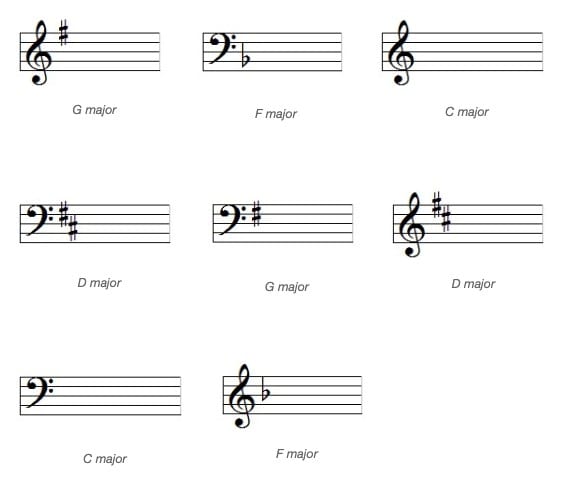Add the clefs and key signatures needed to make these scales.

Key signatures relate to the number of sharps or flats at the beginning of a piece of music. A melody written in the key of ‘C’ will have no sharps or flats in its key signature. However if a melody is written in the key of ‘G’ there will be one sharp as its key signature.
To understand why key signatures are required and their use, study the module on the Major scales.
In grade 1 you will need to know the key signatures of C major, F major, G major and D major.
The following shows the key signatures for these keys using the treble clef and bass clefs:
………………C major……………………….F major…………………..G major…………………….D major

If a melody is written in the key of F major the key signature will include one flat, namely Bb. This means that all B’s at whatever pitch must be played as Bb and not B. Similarly if a melody is written in the key of G major the key signature will include one sharp, namely F#. In the G major key all F’s at whatever pitch must be played as F# and not F.
Download the following questions or write the notes on manuscript before completing.
Name the major keys that have these key signatures.


Add the clefs and key signatures needed to make these scales.

Add the clefs and key signatures needed to make these scales.
F major

The first note of the scale must be the key note. By placing a treble clef on the stave we make the first note an F. The key signature of F major is one flat, namely Bb.
C major

The first note of the scale must be the key note. By placing a bass clef on the stave we make the first note a C. The key signature of C major is no sharps or flats.
D major

The first note of the scale must be the key note. By placing a treble clef on the stave we make the first note a D. The key signature of D major is two sharps, namely F# and C#.
G major

The first note of the scale must be the key note. By placing a bass clef on the stave we make the first note a G. The key signature of G major is one sharp, namely F#.
Name the key of each of these scales. Also draw a bracket over each pair of notes making a semitone.
Key…

Key…

Key………..

Key: G major

This scale starts on the key note G, & G major has one sharp which is F#. There is a semitone between the notes B & C & F# & G.
Key: C major

This scale starts on the key note C, & C major has no sharps or flats in its key signature that is why there are no accidentals in this scale. There is a semitone between the notes C & B & F & E.
Key: F major

This scale starts on the key note F, & F major has one flat which is Bb. There is a semitone between the notes A & Bb & E & F.